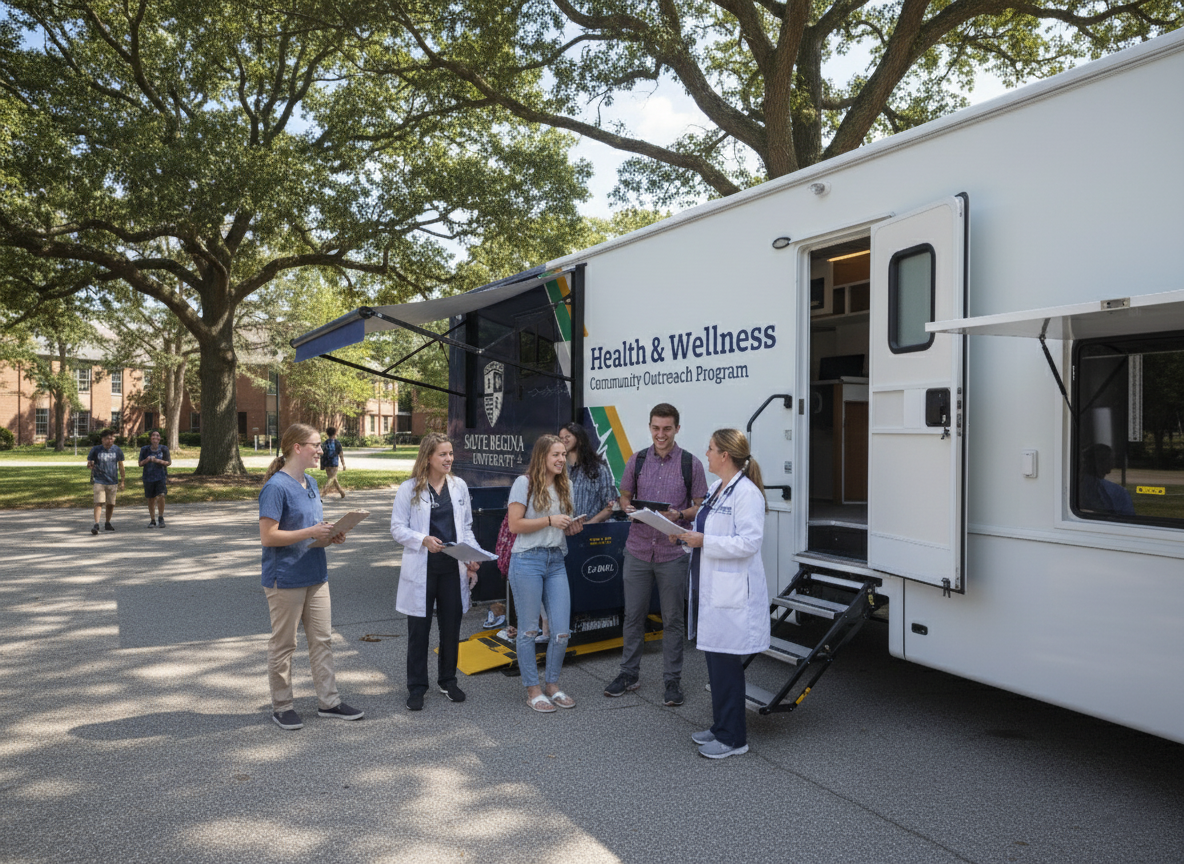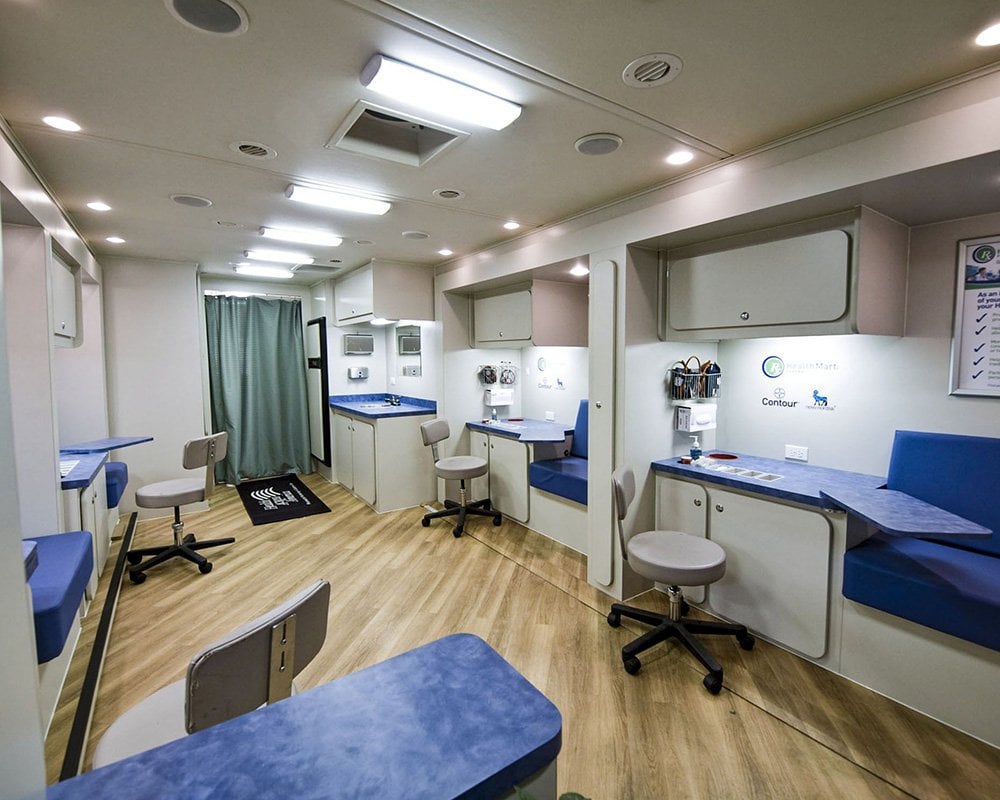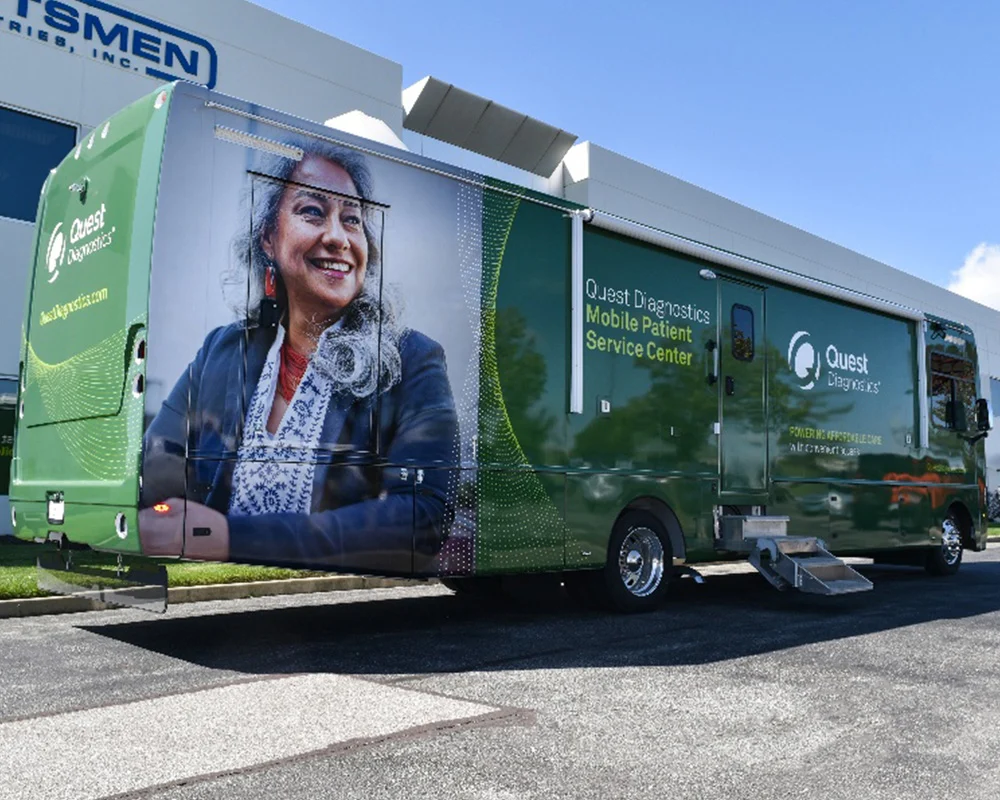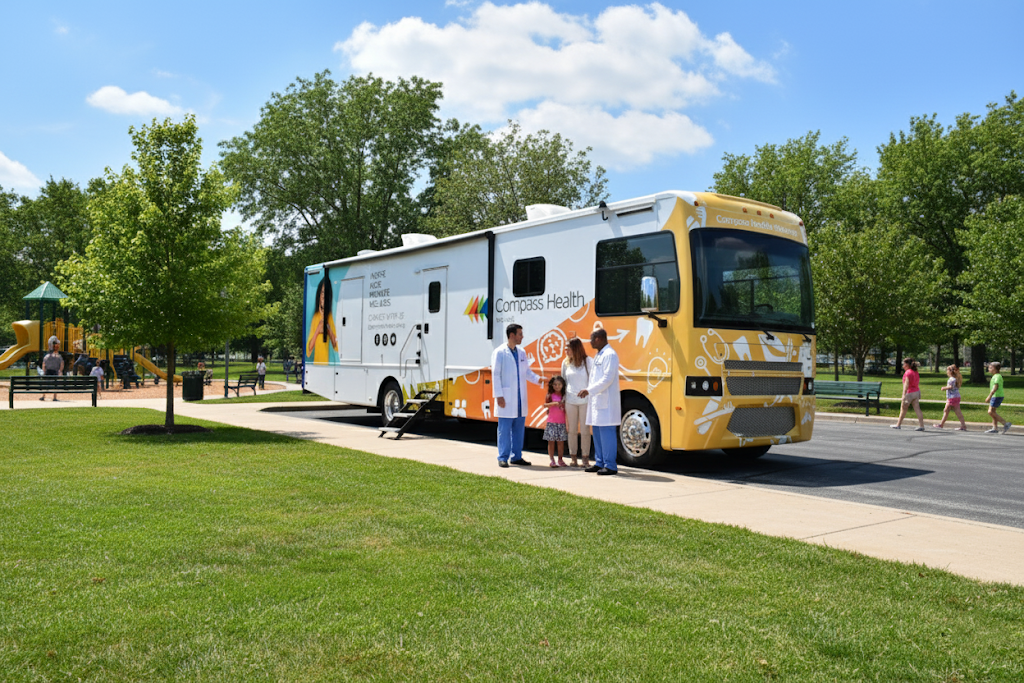HVAC Design Standards for Mobile Clinics
Picture a clinic with wheels, humming softly as it winds through city streets and rural roads, carrying care to those who need it most. Mobile...
8 min read
Craftsmen Industries Oct 20, 2025 5:49:56 AM

Designing a mobile medical vehicle extends beyond simply converting a trailer or RV into a clinic; it involves engineering a space that delivers reliable, safe, and comfortable healthcare on wheels. These vehicles are increasingly vital in bridging healthcare gaps, especially for underserved or rural populations.
Unlike smaller vans, medical trailers and RVs are built to accommodate advanced equipment, multiple staff members, and patients with diverse needs. However, the actual effectiveness of these units depends not just on size but on thoughtful design. Poorly designed vehicles risk non-compliance with medical regulations, pose safety hazards during operation, and lead to negative patient experiences that limit trust and repeat usage.
To overcome these challenges, the design process must prioritize three critical pillars: compliance, safety, and patient comfort. Compliance ensures the unit meets healthcare standards, including ADA accessibility, infection control, and ISO 9001 certifications. Safety covers structural durability, HVAC redundancy, and emergency preparedness. Ultimately, patient comfort significantly impacts the overall experience by providing privacy, accessibility, and a welcoming atmosphere that closely resembles traditional healthcare settings.
When these three pillars are integrated effectively, mobile medical vehicles transform into long-term, scalable solutions. Without wasting any more time, let’s explore each of these pillars in detail, outlining how compliance, safety, and comfort come together to shape effective mobile medical vehicle design.
Thoughtful design is the cornerstone of a successful mobile medical vehicle, directly influencing patient outcomes, staff efficiency, compliance, and long-term trust. Unlike stationary clinics, mobile units face the unique challenge of delivering hospital-level care in a limited space while also remaining fully functional on the move. Every design choice, from the layout of medical equipment to the integration of HVAC and electrical systems, affects how efficiently providers can work and how safe and comfortable patients feel during treatment.
For patients, design has a measurable impact on access and outcomes. A poorly designed space can deter individuals from returning, while a well-planned space fosters privacy, accessibility, and a sense of legitimacy comparable to that of a traditional clinic. Mobile clinics improve healthcare access in rural areas, reducing missed appointments and significantly improving follow-up care.
For healthcare providers, design has a direct impact on workflow efficiency and compliance. Proper placement of equipment and adherence to ADA accessibility and infection control standards not only reduce risks but also help meet regulatory requirements.
Ultimately, design builds trust. Communities are more likely to embrace mobile medical units that feel professional, safe, and patient-centered. By aligning design with compliance, safety, and comfort, healthcare organizations can extend their reach without compromising on care quality.
Designing a mobile medical vehicle isn’t just about functionality; it’s about meeting stringent compliance requirements that ensure accessibility, safety, and high-quality healthcare. Regulatory and certification standards enable mobile units to operate legally while maintaining the same level of trust and reliability as brick-and-mortar healthcare facilities.

Below are key compliance considerations.
The Americans with Disabilities Act (ADA) requires mobile medical units to be fully accessible to patients with disabilities. This includes wheelchair ramps or lifts, widened entry doors, and restroom layouts designed for maneuverability. ADA-compliant vehicles not only meet legal requirements but also expand access to patients who might otherwise be excluded from care.
Hospitals and NGOs often prefer mobile medical vehicles built under ISO 9001 (quality management) and AS9100D (aerospace quality) standards. These certifications demonstrate that manufacturers follow rigorous quality-control processes, ensuring durability, reliability, and safety.
Mobile medical vehicles must comply with the U.S. Department of Transportation (DOT) regulations, covering roadworthiness, weight distribution, braking systems, and lighting. These rules ensure vehicles remain safe to operate across states and during long-distance outreach programs.
Maintaining a clinical-grade environment requires strict adherence to infection prevention guidelines. Mobile medical units must incorporate non-porous, antimicrobial surfaces, adequate ventilation and airflow systems, and rigorous cleaning protocols to ensure a safe and hygienic environment.
Safety is one of the most critical pillars in the design of mobile medical vehicles. Unlike traditional facilities, these units operate in varying environments, from rural roads to disaster zones. This means they must not only comply with healthcare safety protocols but also adapt to transportation risks and unpredictable conditions.
Thoughtful safety design ensures that medical teams can provide uninterrupted care while patients feel protected and secure inside the unit.
Mobile medical vehicles depend heavily on reliable power sources. Without uninterrupted electricity, life-saving equipment such as ventilators, imaging systems, and diagnostic machines cannot function properly. That’s why redundancy is a key design principle.
Most advanced vehicles are equipped with dual power inputs, surge protection systems, and backup generators that automatically activate in case of an outage. This redundancy reduces the risk of downtime and safeguards patients during critical procedures.
Similarly, HVAC systems are more than just climate control; they play a direct role in infection control. Proper air circulation with HEPA filtration minimizes the presence of airborne pathogens, while redundant HVAC units ensure continuous operation even if one system fails.
According to the National Fire Protection Association (NFPA 99), these systems are vital to meeting healthcare facility safety standards.
Durability and fire safety are equally essential. Mobile medical vehicles are exposed to constant vibrations, long-distance transportation, and, in some cases, emergency deployments to disaster-struck regions. To withstand these challenges, they are typically built with reinforced steel frames, crash-resistant walls, and fire-rated construction materials.
Fire protection measures are also mandatory. This includes flame-retardant insulation, smoke alarms, fire extinguishers, and designated fire exits designed for quick evacuation.
Safety is not just about physical structures; it also depends on how people move and interact within the space. Poor workflow design can create hazards, cause delays in emergencies, and increase the risk of cross-contamination.
That’s why medical trailers and RV-based clinics are designed with separated patient intake, examination, and treatment zones. This division not only improves efficiency but also ensures infection control standards are upheld.
In addition, ergonomic layouts help reduce staff fatigue during long shifts, while strategically placed emergency equipment (oxygen lines, defibrillators, and first aid kits) improves rapid response. The Agency for Healthcare Research and Quality (AHRQ) emphasizes the benefits of workflow optimization, which enhances both patient outcomes and staff safety in healthcare environments. These principles apply even more strongly to mobile units, where space is limited and efficiency is vital.

While compliance and safety form the backbone of mobile medical design, patient comfort is equally vital. A positive patient experience not only fosters trust but also encourages individuals to return for care, which is particularly critical in rural areas and underserved communities where healthcare access is already limited.
Studies show that the design of healthcare spaces directly influences patient satisfaction, emotional well-being, and even recovery outcomes. Mobile medical vehicles must therefore strike a balance between efficiency and thoughtful design elements that make patients feel cared for in a professional and welcoming environment.
Privacy is one of the most sensitive aspects of healthcare. Inside a mobile unit, patients should feel secure during consultations and treatments. This is achieved by incorporating soundproof partitions, separate consultation areas, and clear patient flow pathways that prevent overcrowding.
For example, a well-designed trailer often includes a dedicated intake area, exam room, and recovery space to ensure confidentiality at every stage of care.
Privacy has a direct link to trust; patients are more likely to discuss sensitive health issues when they feel protected. By embedding these principles into vehicle layouts, designers help mobile clinics function at the same standard as brick-and-mortar healthcare facilities.
Comfort also comes from ease of movement. For many patients, especially seniors, people with disabilities, or those with mobility challenges, the layout of the vehicle can either reduce or increase stress. Design features such as wide entry ramps, ADA-compliant doors, grab bars, and non-slip flooring significantly improve accessibility.
Inside, exam tables, seating, and equipment must be arranged with ergonomic efficiency, allowing staff to move freely without compromising patient dignity or comfort. Accessibility isn’t just about physical entry; it extends to how staff can efficiently operate equipment and interact with patients in a supportive environment. The ADA National Network emphasizes that accessible design not only improves inclusivity but also builds long-term trust within communities.
Beyond structure, the look and feel of a medical vehicle can dramatically impact patient perception. Studies in healthcare design have highlighted how lighting, noise control, and color schemes influence stress levels and the healing process. For instance, natural light or warm LED lighting reduces anxiety, while noise-reduction materials create a calmer environment.
Color choices also play a role; soft, neutral palettes can foster a sense of relaxation, while brighter colors can be used in pediatric units to create a welcoming, friendly space.
Designing a mobile medical vehicle requires striking the right balance between compliance, safety, and patient comfort; three pillars that collectively determine the vehicle’s effectiveness. Suppose one element is prioritized too heavily while the others are overlooked. In that case, the result can be a mobile unit that is technically functional but fails to deliver trusted, long-term care.
Hospitals, NGOs, and governments investing in these vehicles must therefore approach design as a holistic process rather than a checklist of requirements.
Regulatory standards such as ADA accessibility, ISO certifications, and DOT safety rules ensure that mobile medical units operate at the highest levels of accountability. Yet, strict compliance can sometimes reduce flexibility in the floor plan or patient areas.
This is where modular layouts and foldable furniture provide solutions that maximize space without compromising compliance. Moreover, efficient floor planning enables mobile units to meet regulations while maintaining a smooth patient flow and staff efficiency.
Safety features like fire exits, reinforced structural integrity, and redundant HVAC systems are non-negotiable in a healthcare setting. However, these features must also enhance, not diminish, patient comfort. For instance, HVAC systems not only regulate temperature but also improve air quality, which has a direct impact on patient well-being.
Craftsman notes that poorly designed climate control leads to discomfort, higher anxiety levels, and reduced patient trust. The best designs use redundant systems that protect against failure while ensuring a calm and stable environment.
A welcoming interior with soft lighting, reduced noise, and private consultation areas builds patient trust and encourages repeat visits. Yet, comfort must never override the necessity for infection control. The use of antimicrobial surfaces, easy-to-clean flooring, and controlled airflow systems creates an environment that is both hygienic and inviting. Moreover, the material selection in healthcare spaces has a direct impact on both patient safety and emotional well-being.
True success emerges when these three pillars support one another, rather than competing with each other. A well-balanced mobile medical vehicle offers regulatory compliance while minimizing patient crowding, provides robust safety measures without compromising comfort, and maintains a welcoming atmosphere without neglecting infection control.
In real-world applications, such as rural outreach clinics or disaster-relief units, this balance ensures both immediate functionality and long-term trust in mobile healthcare.
When compliance, safety, and comfort are integrated thoughtfully, mobile medical vehicles transform into scalable healthcare solutions that reliably serve diverse populations, regardless of the setting.
Mobile medical vehicles must comply with multiple standards: ADA for accessibility, ISO 9001 for quality management, AS9100D for safety-critical industries, DOT for road safety, and infection control guidelines such as CDC recommendations. These ensure legal compliance, patient safety, and international credibility.
Design features such as non-porous antimicrobial surfaces, high-efficiency ventilation systems, and rigorous cleaning protocols help reduce the risk of contamination. Mobile units often incorporate negative pressure zones and medical-grade air filtration systems to meet stringent healthcare standards.
Yes. Modern trailers can accommodate diagnostic imaging machines, dental units, lab testing devices, and even minor surgical equipment, provided they are designed with the right power supply, HVAC redundancy, and regulatory compliance. This flexibility allows them to function like traditional hospitals.
Privacy is ensured through separate consultation rooms, partitions, soundproofed walls, and a well-organized patient flow layout. These features make patients feel secure and encourage trust in mobile healthcare settings.
Key comfort factors include ambient lighting, noise reduction materials, ergonomic layouts, ADA-compliant accessibility, and efficient climate control. Together, these elements create a more welcoming and less stressful environment for patients.
Designing a mobile medical vehicle is more than simply fitting medical equipment into a coach or a trailer; it’s about striking a balance between compliance, safety, and patient comfort to deliver consistent, high-quality care wherever it’s needed. From ADA accessibility and ISO-certified builds to structural safety and patient-centered design, these three pillars ensure that mobile clinics not only meet regulatory standards but also inspire trust and improve health outcomes.
When thoughtfully designed, mobile medical vehicles transform into scalable, long-term healthcare solutions that can serve diverse communities with confidence. For organizations exploring the next step, investing in professionally engineered medical trailers is the surest path to success. That’s where Craftsmen Industries stands out.
With decades of expertise in designing medical trailers that meet strict compliance standards, they help hospitals, NGOs, and government programs launch reliable mobile healthcare initiatives without compromising on quality or safety. Partnering with specialists ensures your mobile unit is not only compliant but also built for comfort, durability, and patient trust.

Picture a clinic with wheels, humming softly as it winds through city streets and rural roads, carrying care to those who need it most. Mobile...

Mobile medical coaches are crucial for providing necessary and often life-saving healthcare. These spacious vehicles carry essential and...

Mobile medical vehicles are moving clinics built into trailers, RVs, or trucks (not vans). Think of them as hospitals on wheels that bring care...